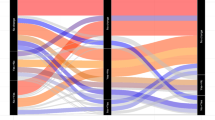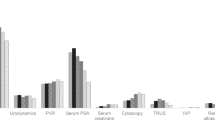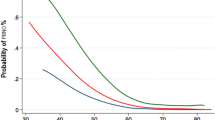Abstract
Disease progression has become an important issue for the management of lower urinary tract symptoms/benign prostatic hyperplasia (LUTS/BPH). Although several risk factors have been identified, no specific patient risk profiles have been established that can be useful in the day-to-day management of LUTS/BPH. In this study, an international panel of urologists developed a risk classification based on the attribution of a risk score to 243 unique patient profiles. From the perspective of clinical decision making, it was concluded that postvoid residual, symptom severity and maximum flow rate are the most relevant determinants of the risk of disease progression.
This is a preview of subscription content, access via your institution
Access options
Subscribe to this journal
Receive 4 print issues and online access
$259.00 per year
only $64.75 per issue
Buy this article
- Purchase on Springer Link
- Instant access to full article PDF
Prices may be subject to local taxes which are calculated during checkout

Similar content being viewed by others
References
Jacobsen SJ et al. Natural history of prostatism: risk factors for acute urinary retention. J Urol 1997; 158: 481–487.
McConnell JD et al. The effect of finasteride on the risk of acute urinary retention and the need for surgical treatment among men with benign prostatic hyperplasia. Finasteride Long-Term Efficacy and Safety Study Group. N Engl J Med 1998; 338: 557–563.
Roehrborn CG et al. Serum prostate-specific antigen concentration is a powerful predictor of acute urinary retention and need for surgery in men with clinical benign prostatic hyperplasia. PLESS Study Group. Urology 1999; 53: 473–480.
McConnell JD et al. Baseline measures predict the risk of benign prostatic hyperplasia clinical progression in placebo-treated patients. J Urol 2003; 169 (Suppl): 332 (Abstract 1287).
Roehrborn CG, Boyle P, Nickel JC . PSA is a significant predictor of objective parameters in men at risk of BPH progression. J Urol 2003; 169 (Suppl): 364–365 (Abstract 1362).
McConnell JD et al. The long-term effect of doxazosin, finasteride, and combination therapy on the clinical progression of benign prostatic hyperplasia. N Engl J Med 2003; 349: 2387–2398.
Jimenez-Cruz F . Identifying patients with lower urinary tract symptoms/benign prostatic hyperplasia (LUTS/BPH) at risk for progression. Eur Urol Suppl 2003; 2: 6–12.
Kaplan SA et al. Baseline symptoms, uroflow, and post-void residual urine as predictors of BPH clinical progression in the medically treated arms of the MTOPS trial. J Urol 2003; 169 (4 Suppl): 332–333 (Abstract 1289).
Speakman MJ et al. Integrating risk profiles in the treatment choice for patients with lower urinary tract symptoms/benign prostatic hyperplasia. A systematic analysis of expert opinion. Eur Urol Suppl 2004; 3: 61 (Abstract 233).
Brook RH et al. A method for the detailed assessment of the appropriateness of medical technologies. Int J Technol Assess Health Care 1986; 2: 53–63.
Meesen B . LUTS/BPH progression A literature review on risk factors for progression and impact of medical therapy on progression. Lier (Belgium), ISMAR Healthcare. 2003.
Lowe F et al. Risk factors for disease progression in patients with lower urinary tract symptoms/benign prostatic hyperplasia; a systematic analysis of expert opinion. Eur Urol Suppl 2004; 3: 39 (Abstract 147).
Djavan B, Nickel JC, de la Rosette J, Abrams P . The urologist view of BPH progression: results of an international survey. Eur Urol 2002; 41: 490–496.
McNicholas T . LUTS, the case is altered. Eur Urol Suppl 2002; 1: 28–35.
Acknowledgements
This study was supported by an unrestricted educational grant from Boehringer Ingelheim GmbH.
Author information
Authors and Affiliations
Corresponding author
Rights and permissions
About this article
Cite this article
Lowe, F., Batista, J., Berges, R. et al. Risk factors for disease progression in patients with lower urinary tract symptoms/benign prostatic hyperplasia (LUTS/BPH): a systematic analysis of expert opinion. Prostate Cancer Prostatic Dis 8, 206–209 (2005). https://doi.org/10.1038/sj.pcan.4500806
Received:
Accepted:
Published:
Issue Date:
DOI: https://doi.org/10.1038/sj.pcan.4500806
Keywords
This article is cited by
-
Impact of medical treatment on storage and voiding LUTS, nocturia, and quality of life in men at risk for progression
Prostate Cancer and Prostatic Diseases (2023)
-
Nocturia and its impact on health-related quality of life and health care seeking behaviour in German community-dwelling men aged 50 years or older
World Journal of Urology (2014)
-
Epidemiologie des benignen Prostatasyndroms
Der Urologe (2008)
-
Management of non-complicated BPH: proposition of a renewed decision tree
World Journal of Urology (2006)
-
Integrating risk profiles for disease progression in the treatment choice for patients with lower urinary tract symptoms/benign prostatic hyperplasia: a combined analysis of external evidence and clinical expertise
Prostate Cancer and Prostatic Diseases (2005)



